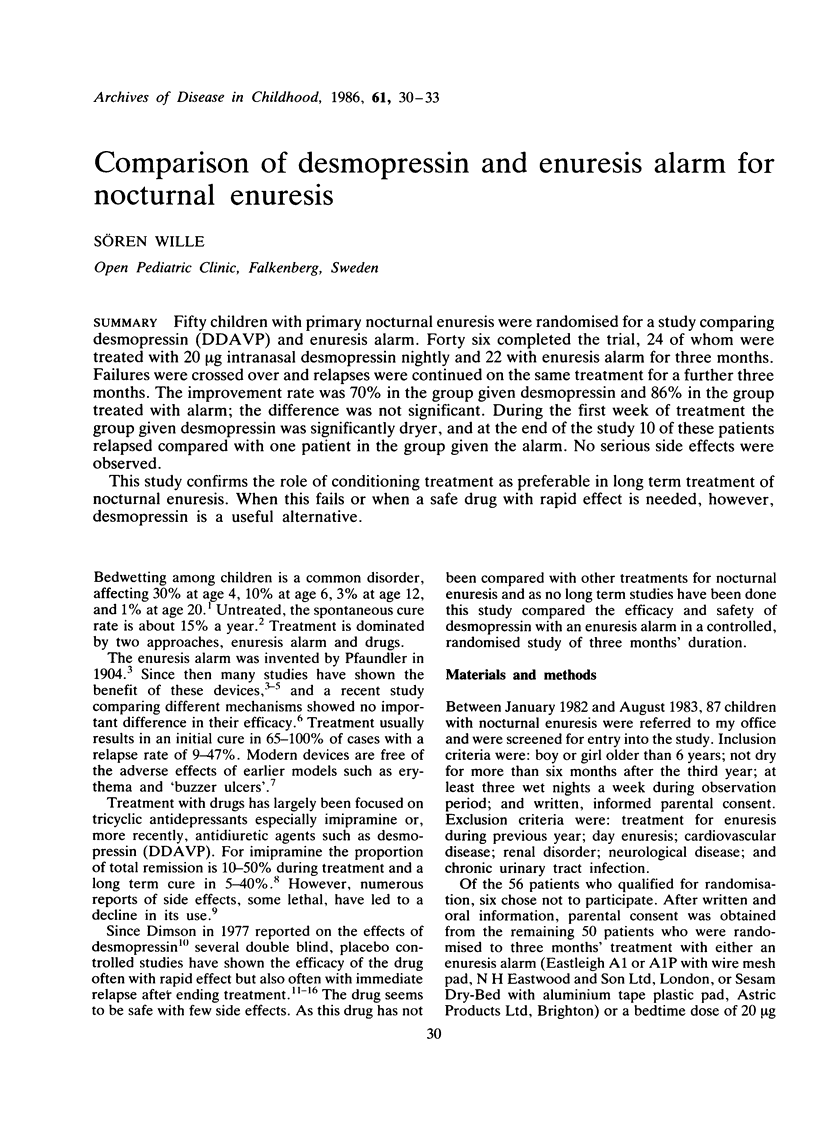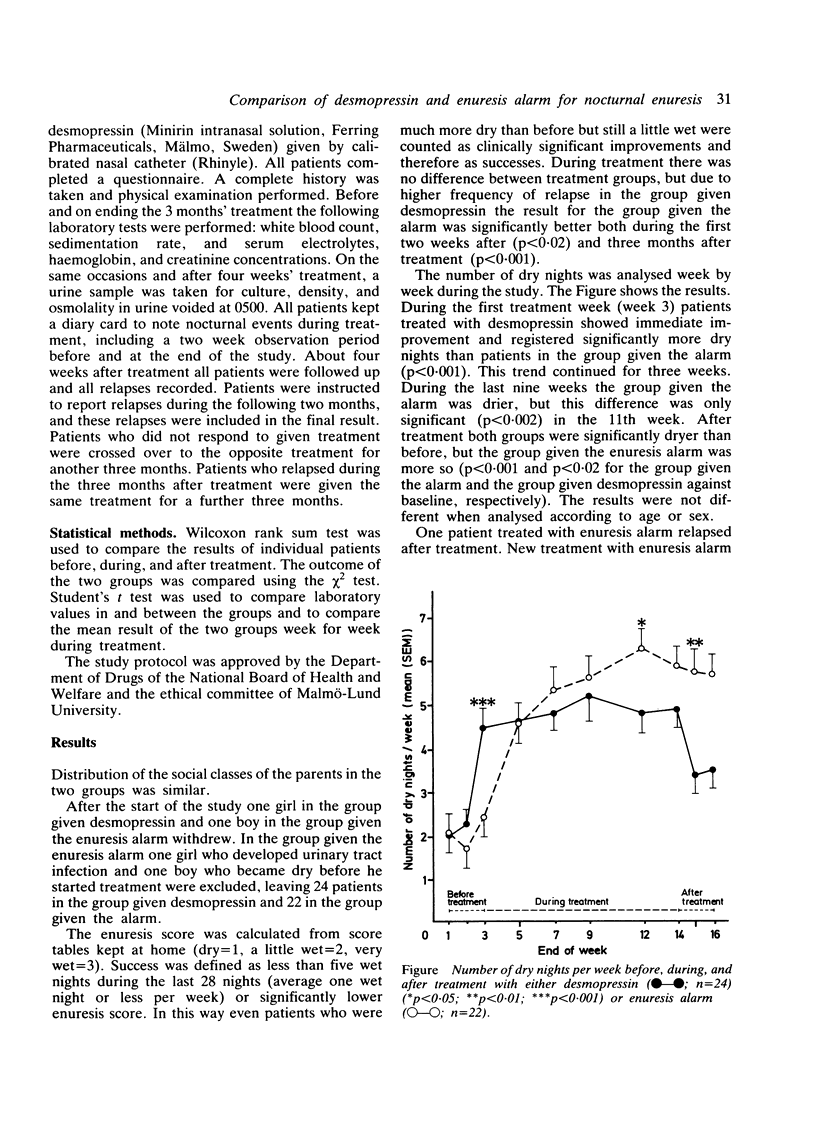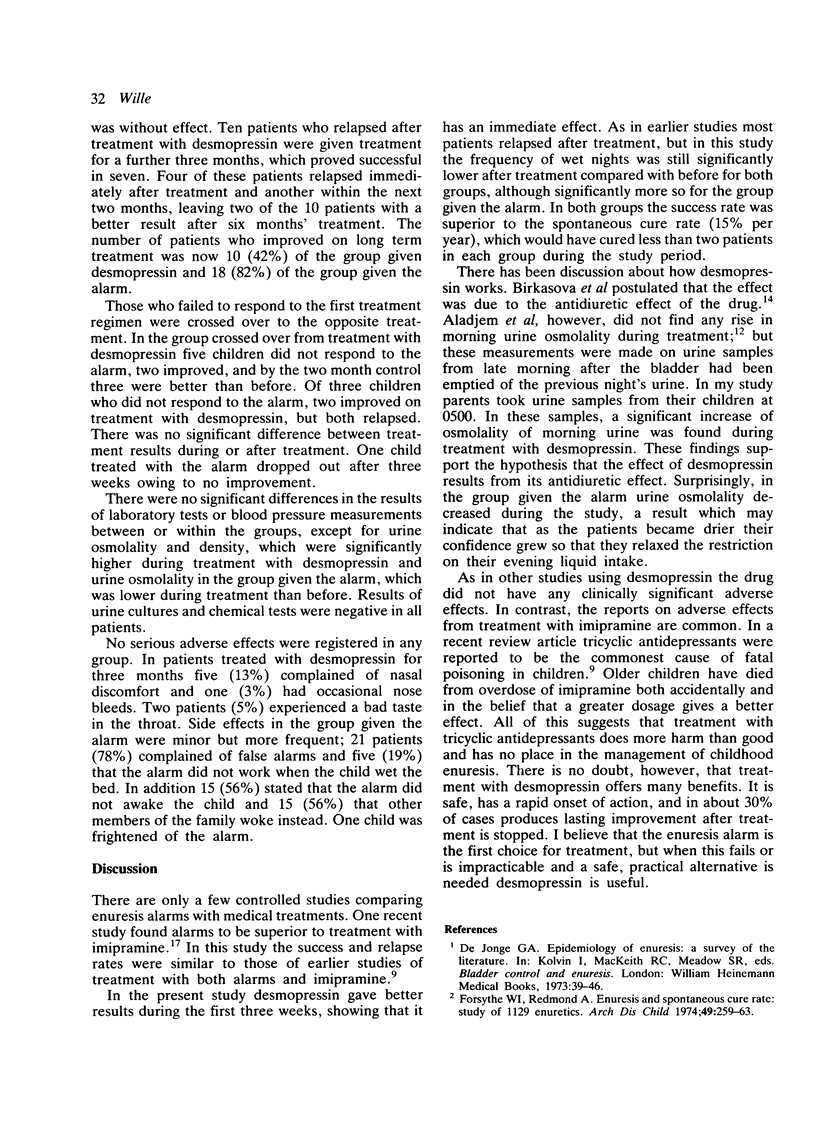Abstract
Fifty children with primary nocturnal enuresis were randomised for a study comparing desmopressin (DDAVP) and enuresis alarm. Forty six completed the trial, 24 of whom were treated with 20 micrograms intranasal desmopressin nightly and 22 with enuresis alarm for three months. Failures were crossed over and relapses were continued on the same treatment for a further three months. The improvement rate was 70% in the group given desmopressin and 86% in the group treated with alarm; the difference was not significant. During the first week of treatment the group given desmopressin was significantly dryer, and at the end of the study 10 of these patients relapsed compared with one patient in the group given the alarm. No serious side effects were observed. This study confirms the role of conditioning treatment as preferable in long term treatment of nocturnal enuresis. When this fails or when a safe drug with rapid effect is needed, however, desmopressin is a useful alternative.
Full text
PDF



Selected References
These references are in PubMed. This may not be the complete list of references from this article.
- Aladjem M., Wohl R., Boichis H., Orda S., Lotan D., Freedman S. Desmopressin in nocturnal enuresis. Arch Dis Child. 1982 Feb;57(2):137–140. doi: 10.1136/adc.57.2.137. [DOI] [PMC free article] [PubMed] [Google Scholar]
- Bengtsson B. Behandling av nattväta med enuresalarm - preliminära resultat från 100 konsekutiva fall. Lakartidningen. 1981 Jul 22;78(30-31):2701–2703. [PubMed] [Google Scholar]
- Birkásová M., Birkás O., Flynn M. J., Cort J. H. Desmopressin in the management of nocturnal enuresis in children: a double-blind study. Pediatrics. 1978 Dec;62(6):970–974. [PubMed] [Google Scholar]
- Dimson S. B. Desmopressin as a treatment for enuresis. Lancet. 1977 Jun 11;1(8024):1260–1260. doi: 10.1016/s0140-6736(77)92467-9. [DOI] [PubMed] [Google Scholar]
- Forsythe W. I., Redmond A. Enuresis and spontaneous cure rate. Study of 1129 enuretis. Arch Dis Child. 1974 Apr;49(4):259–263. doi: 10.1136/adc.49.4.259. [DOI] [PMC free article] [PubMed] [Google Scholar]
- Goel K. M., Thomson R. B., Gibb E. M., McAinsh T. F. Evaluation of nine different types of enuresis alarms. Arch Dis Child. 1984 Aug;59(8):748–752. doi: 10.1136/adc.59.8.748. [DOI] [PMC free article] [PubMed] [Google Scholar]
- Kjøller S. S., Hejl M., Pedersen P. S. Enuresis nocturna behandlet med minurin (DDAVP). En kontrolleret klinisk undersøgelse. Ugeskr Laeger. 1984 Oct 22;146(43):3281–3282. [PubMed] [Google Scholar]
- Post E. M., Richman R. A., Blackett P. R., Duncan K. P., Miller K. Desmopressin response of enuretic children. Effects of age and frequency of enuresis. Am J Dis Child. 1983 Oct;137(10):962–963. doi: 10.1001/archpedi.1983.02140360026009. [DOI] [PubMed] [Google Scholar]
- Schmitt B. D. Nocturnal enuresis: an update on treatment. Pediatr Clin North Am. 1982 Feb;29(1):21–36. doi: 10.1016/s0031-3955(16)34105-0. [DOI] [PubMed] [Google Scholar]
- Terho P., Kekomäki M. Management of nocturnal enuresis with a vasopressin analogue. J Urol. 1984 May;131(5):925–927. doi: 10.1016/s0022-5347(17)50714-4. [DOI] [PubMed] [Google Scholar]
- Tuvemo T. DDAVP in childhood nocturnal enuresis. Acta Paediatr Scand. 1978 Nov;67(6):753–755. doi: 10.1111/j.1651-2227.1978.tb16255.x. [DOI] [PubMed] [Google Scholar]
- Tøjner H. Behandling af enuresis nocturna med konditioneringsapparat. Behandling af 934 børn i almen praksis. Ugeskr Laeger. 1979 Mar 12;141(11):722–726. [PubMed] [Google Scholar]
- Wagner W., Johnson S. B., Walker D., Carter R., Wittner J. A controlled comparison of two treatments for nocturnal enuresis. J Pediatr. 1982 Aug;101(2):302–307. doi: 10.1016/s0022-3476(82)80146-7. [DOI] [PubMed] [Google Scholar]


